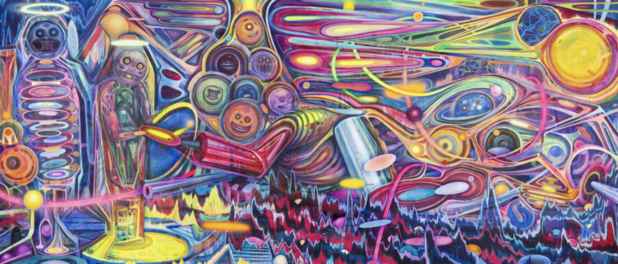Huang Yuxing “An Absolute Power We Cannot Find”
Almine Rech Gallery

This event has ended.
Almine Rech presents Huang Yuxing’s first-ever New York exhibition and his second solo show at the gallery. Comprising eleven paintings completed over the last four years, An Absolute Power We Cannot Find articulates an ambitious vision, one that encompasses modern treatments of ancient subjects and that reconciles elements of East and West, with subjects ranging from humble human figures to a fearsome image of the cosmos.
Born in 1975 in Beijing, where he still lives, Huang earned a degree in mural painting in 2000 from that city’s Central Academy of Fine Arts. Since then, he has participated in numerous group exhibitions and had solo shows at distinguished galleries and museums throughout China and Europe. His work has appeared at institutions including the West Bund Museum, Shanghai; Minsheng Modern Art Museum, Shanghai; and Powerlong Museum, Shanghai, and he was the first guest artist at the project room at the Yuz Museum, West Bund, Shanghai.
Looming over the show and suggesting its grand scope is the six-meter-wide Slave Universe, in which a sun-like sphere illuminates a roiling galaxy, where multicolored orbs and lines of energy riotously zip through space. A cascade of heads, meanwhile, seemingly watches over two figures who appear locked in place; in all, it suggests a science-fiction world, maybe something like the fields in which enslaved humans are kept unconscious in The Matrix, providing fuel for their robot masters.
But Huang’s vision is much more bold than an earthly war between humans and machines. When asked who is the slave and who is the master, his answer is surprisingly far-reaching: “I actually think,” he says, “that the whole universe is the slave.” The more he learns of the universe, the more mysterious it becomes, and the more inscrutable who or what the absolute power might be.
Several paintings depict human figures, from the everyday to the holy; the artist treats them similarly in compositional terms, akin to his desire to treat them as spiritual equals.
Two of these works, the ones depicting everyday people, are bound to the moment in which they were created, one defined by plague and global conflict. Youxiu Han’s live streaming studio shows a fellow-artist Huang befriended during the Covid-19 pandemic through Youxiu Han’s online presentations of his work. A svelte figure sporting a helmet appears in the anti-war statement Ukrainian Mother; though she is made anonymous by a gas mask, she, too, is based on someone Huang came to know on-screen during the pandemic, a Chinese mother.
Two other canvases represent the kinds of figures society places on pedestals. The artist presents his take on the traditional Western subject of the Holy Family in Sacra Famiglia. Meanwhile, Nikola Tesla shows the Serbian-American inventor (1856-1943) whose work with electricity was foundational to modern technology and who invented the Tesla coil, indispensable for early radio transmitters. He holds in his hand a simplified version of the Tesla Tower, an experimental wireless transmission center he designed and built at the beginning of the twentieth century.
Huang depicts landscapes in a pair of canvases titled Peaks, showing near-abstract mountainous terrain in day and night respectively, and a quartet named Pine, one devoted to each of the seasons. Each Pine canvas shows rivers flowing through mountainous terrain covered in pine trees, motifs that are mainstays of classical Chinese scroll paintings, which these works’ vertical compositions allude to. “The river is one of my favorite subjects,” the artist has said; “it defines the shape of time in my mind’s eye.”
Throughout the show, Huang uses fluorescent colors, a twentieth-century innovation that has been a cornerstone of his work for years, even as he depicts timeless subjects. “Fluorescent color is the color of our generation,” he has said. “There is no such color system in traditional easel paintings. It is special, like a kind of vigorous vitality being compressed or unleashed.” Not only is the distinctive color scheme significant for Huang; in his mind, the blending of oil and water in his acrylic paint symbolizes the meeting of East and West; the use of contemporary color and line to treat an ancient subject similarly reconciles a contrast.
Though the artist has recently created work in the newest art medium, namely NFTs, he remains committed to painting. Working in this ancient medium, he says, places him in a dialogue with masters of the medium throughout history.
“It’s a very old game,” he says, “but new people keep coming in to play it.” - Brian Boucher, critic and journalist.
Media
Schedule
from November 03, 2022 to December 17, 2022
Opening Reception on 2022-11-03 from 18:00 to 20:00